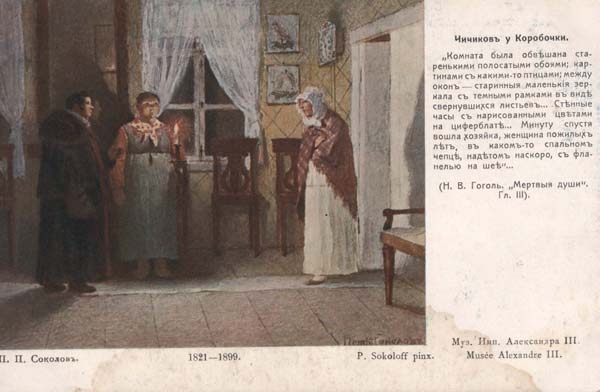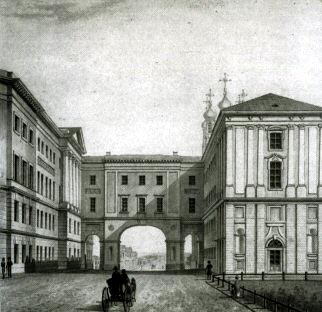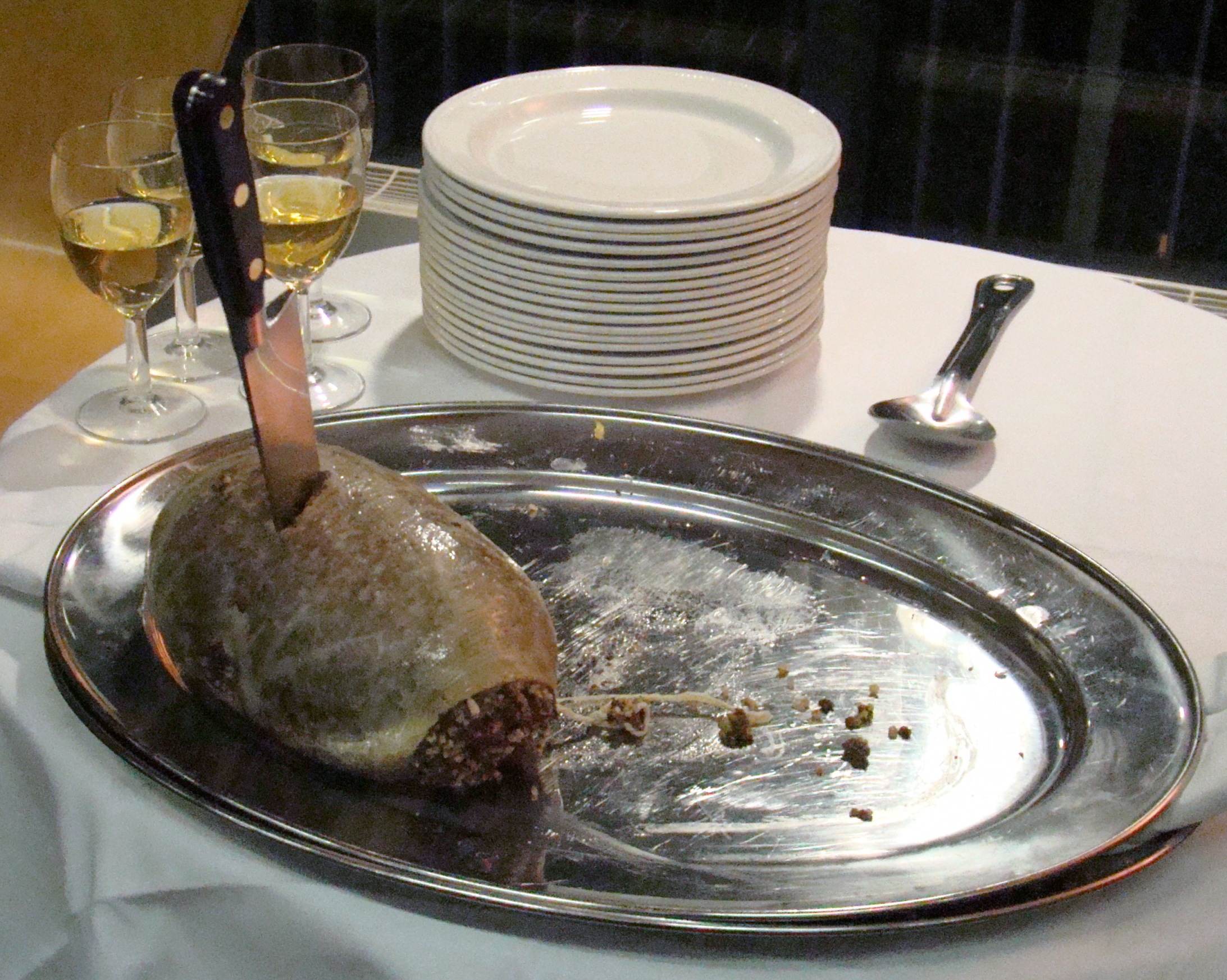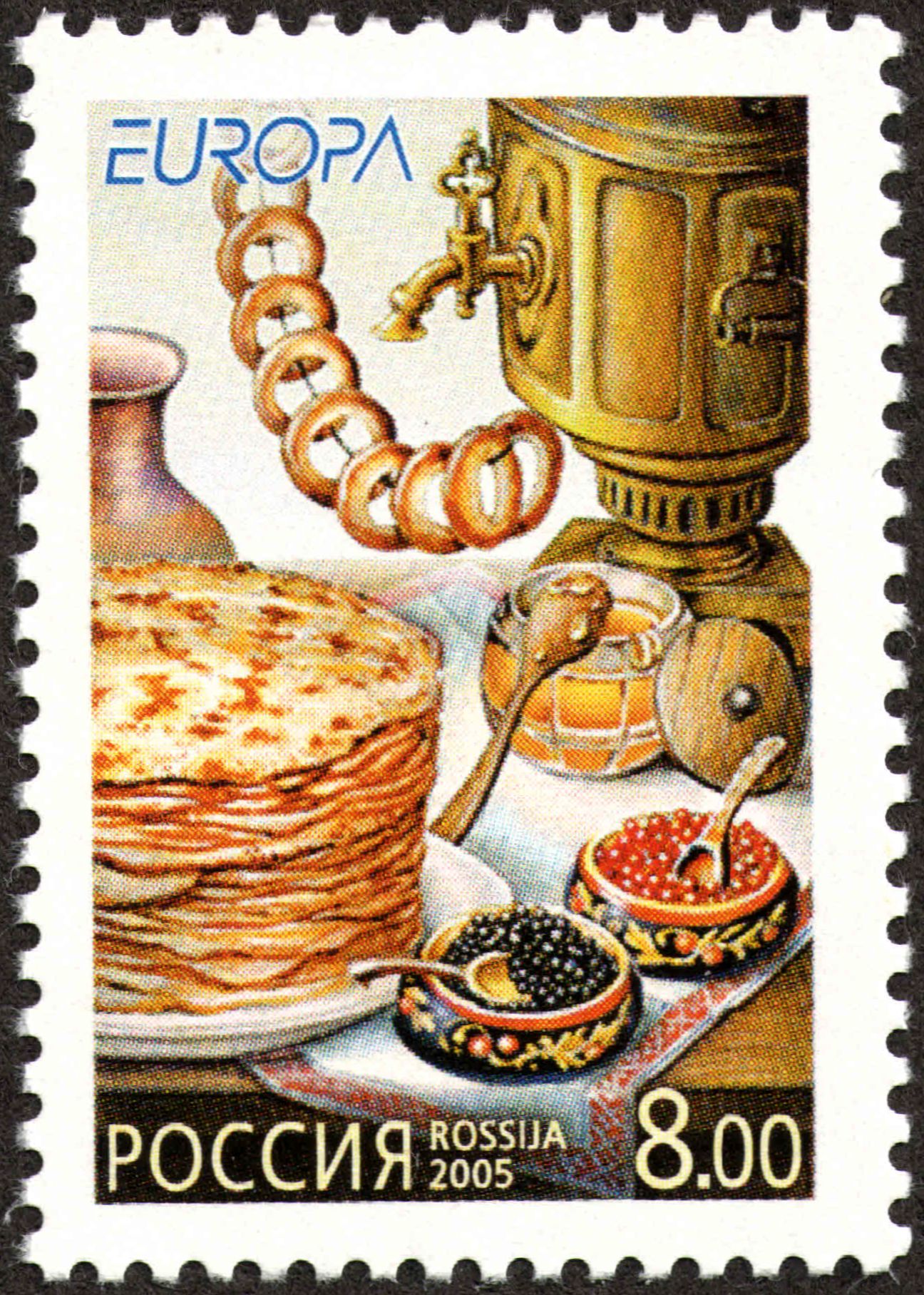|
Nyanya (dish)
Nyanya or niania ( rus, няня) is an ancient Russian dish. It consists of a sheep's abomasum stuffed with mutton brains, head meat, legs, onion and buckwheat porridge. After that, the dish can be fried in lard or baked in the oven in a clay pot. History The dish is known from the 9th century. Nyanya was forbidden by the Russian Orthodox Church because pagan Slavs used the dish in their rituals. In literature The nyanya is mentioned in "Dead Souls" by Nikolai Gogol: "My dear," said Sobakevitch, "the cabbage soup is excellent." With that he finished his portion, and helped himself to a generous measure of niania, the dish which follows shtchi and consists of a sheep's stomach stuffed with black porridge, brains, and other things. "What niania this is!" he added to Chichikov. "Never would you get such stuff in a town, where one is given the devil knows what." The dish is also mentioned in the Saltykov-Shchedrin's novel "Old Years in Poshekhonye". See also * Haggis * List of Ru ... [...More Info...] [...Related Items...] OR: [Wikipedia] [Google] [Baidu] |
Russia
Russia (, , ), or the Russian Federation, is a List of transcontinental countries, transcontinental country spanning Eastern Europe and North Asia, Northern Asia. It is the List of countries and dependencies by area, largest country in the world, with its internationally recognised territory covering , and encompassing one-eighth of Earth's inhabitable landmass. Russia extends across Time in Russia, eleven time zones and shares Borders of Russia, land boundaries with fourteen countries, more than List of countries and territories by land borders, any other country but China. It is the List of countries and dependencies by population, world's ninth-most populous country and List of European countries by population, Europe's most populous country, with a population of 146 million people. The country's capital and List of cities and towns in Russia by population, largest city is Moscow, the List of European cities by population within city limits, largest city entirely within E ... [...More Info...] [...Related Items...] OR: [Wikipedia] [Google] [Baidu] |
Abomasum
The abomasum, also known as the maw,The Chambers Dictionary, Ninth Edition, Chambers Harrap Publishers, 2003 rennet-bag, or reed tripe, is the fourth and final compartment in . It secretes , which is used in creation. The word ''abomasum'' (''ab-'' "away from" ... [...More Info...] [...Related Items...] OR: [Wikipedia] [Google] [Baidu] |
Buckwheat
Buckwheat (''Fagopyrum esculentum''), or common buckwheat, is a flowering plant in the knotweed family Polygonaceae cultivated for its grain-like seeds and as a cover crop. The name "buckwheat" is used for several other species, such as '' Fagopyrum tataricum'', a domesticated food plant raised in Asia. Despite its name, buckwheat is not closely related to wheat. It is not a cereal, nor is it even a member of the grass family. Buckwheat is related to sorrel, knotweed, and rhubarb, and is known as a pseudocereal because its seeds' culinary use is the same as cereals, owing to their high starch content. Etymology The name "buckwheat" or "beech wheat" comes from its triangular seeds, which resemble the much larger seeds of the beech nut from the beech tree, and the fact that it is used like wheat. The word may be a translation of Middle Dutch ''boecweite'': ''boec'' (Modern Dutch ''beuk''), "beech" (see PIE *''bhago''-) and ''weite'' (Mod. Dut. ''tarwe'', antiquated Dut. '' ... [...More Info...] [...Related Items...] OR: [Wikipedia] [Google] [Baidu] |
Russian Orthodox Church
, native_name_lang = ru , image = Moscow July 2011-7a.jpg , imagewidth = , alt = , caption = Cathedral of Christ the Saviour in Moscow, Russia , abbreviation = ROC , type = , main_classification = Eastern Orthodox , orientation = Russian Orthodoxy , scripture = Elizabeth Bible ( Church Slavonic) Synodal Bible (Russian) , theology = Eastern Orthodox theology , polity = Episcopal , governance = Holy Synod of the Russian Orthodox Church , structure = Communion , leader_title = , leader_name = , leader_title1 = Primate , leader_name1 = Patriarch Kirill of Moscow , leader_title2 = , leader_name2 = , leader_title3 = Bishops , leader_name3 = 382 (2019) , fellowships_type = Clergy , fellowships = 40,514 full-time clerics, including 35,677 presbyters and 4,837 de ... [...More Info...] [...Related Items...] OR: [Wikipedia] [Google] [Baidu] |
Slavs
Slavs are the largest European ethnolinguistic group. They speak the various Slavic languages, belonging to the larger Balto-Slavic branch of the Indo-European languages. Slavs are geographically distributed throughout northern Eurasia, mainly inhabiting Central and Eastern Europe, and the Balkans to the west; and Siberia to the east. A large Slavic minority is also scattered across the Baltic states and Central Asia, while a substantial Slavic diaspora is found throughout the Americas, as a result of immigration. Present-day Slavs are classified into East Slavs (chiefly Belarusians, Russians, Rusyns, and Ukrainians), West Slavs (chiefly Czechs, Kashubians, Poles, Slovaks and Sorbs) and South Slavs (chiefly Bosniaks, Bulgarians, Croats, Macedonians, Montenegrins, Serbs and Slovenes). The vast majority of Slavs are traditionally Christians. However, modern Slavic nations and ethnic groups are considerably diverse both genetically and culturally, and relations between them � ... [...More Info...] [...Related Items...] OR: [Wikipedia] [Google] [Baidu] |
Dead Souls
''Dead Souls'' (russian: «Мёртвые души», ''Mjórtvyje dúshi'') is a novel by Nikolai Gogol, first published in 1842, and widely regarded as an exemplar of 19th-century Russian literature. The novel chronicles the travels and adventures of Pavel Ivanovich Chichikov (Russian: Павел Иванович Чичиков) and the people whom he encounters. These people typify the Russian middle aristocracy of the time. Gogol himself saw his work as an "epic poem in prose", and within the book characterised it as a " novel in verse". Gogol intended the novel to be the first part of a three-volume work, but burned the manuscript of the second part shortly before his death. Although the novel ends in mid-sentence (like Sterne's ''Sentimental Journey''), it is regarded by some as complete in the extant form. Title The original title, as shown on the illustration (cover page), was "The Wanderings of Chichikov, or Dead Souls. ''Poema''", which contracted to merely "Dead ... [...More Info...] [...Related Items...] OR: [Wikipedia] [Google] [Baidu] |
Nikolai Gogol
Nikolai Vasilyevich Gogol; uk, link=no, Мико́ла Васи́льович Го́голь, translit=Mykola Vasyliovych Hohol; (russian: Яновский; uk, Яновський, translit=Yanovskyi) ( – ) was a Russian novelist, short story writer and playwright of Ukrainian origin. Gogol was one of the first to use the technique of the grotesque, in works such as " The Nose", " Viy", "The Overcoat", and "Nevsky Prospekt". These stories, and others such as " Diary of a Madman", have also been noted for their proto-surrealist qualities. According to Viktor Shklovsky, Gogol's strange style of writing resembles the "ostranenie" technique of defamiliarization. His early works, such as ''Evenings on a Farm Near Dikanka'', were influenced by his Ukrainian upbringing, Ukrainian culture and folklore. His later writing satirised political corruption in the Russian Empire (''The Government Inspector'', '' Dead Souls''). The novel ''Taras Bulba'' (1835), the play ''Marriage ... [...More Info...] [...Related Items...] OR: [Wikipedia] [Google] [Baidu] |
Mikhail Saltykov-Shchedrin
Mikhail Yevgrafovich Saltykov-Shchedrin ( rus, Михаи́л Евгра́фович Салтыко́в-Щедри́н, p=mʲɪxɐˈil jɪvˈɡrafəvʲɪtɕ səltɨˈkof ɕːɪˈdrʲin; – ), born Mikhail Yevgrafovich Saltykov and known during his lifetime by the pen name Nikolai Shchedrin ( rus, Николай Щедрин), was a major Russian writer and satirist of the 19th century. He spent most of his life working as a civil servant in various capacities. After the death of poet Nikolay Nekrasov, he acted as editor of a Russian literary magazine ''Otechestvenniye Zapiski'' until the Tsarist government banned it in 1884. In his works Saltykov mastered both stark realism and satirical grotesque merged with fantasy. His most famous works, the family chronicle novel ''The Golovlyov Family'' (1880) and the political novel ''The History of a Town'' (1870) became important works of 19th-century fiction, and Saltykov is regarded as a major figure of Russian literary Realism. B ... [...More Info...] [...Related Items...] OR: [Wikipedia] [Google] [Baidu] |
Haggis
Haggis ( gd, taigeis) is a savoury pudding containing sheep's pluck (heart, liver, and lungs), minced with onion, oatmeal, suet, spices, and salt, mixed with stock, and cooked while traditionally encased in the animal's stomach though now an artificial casing is often used instead. According to the 2001 English edition of the ''Larousse Gastronomique'': "Although its description is not immediately appealing, haggis has an excellent nutty texture and delicious savoury flavour". It is believed that food similar to haggis—perishable offal quickly cooked inside an animal's stomach, all conveniently available after a hunt—was eaten from ancient times. Although the name "hagws" or "hagese" was first recorded in England c. 1430, the dish is considered traditionally of Scottish origin. It is even the national dish, as a result of Scots poet Robert Burns' poem "Address to a Haggis" of 1786. Haggis is traditionally served with "neeps and tatties", boiled and mashed separately, and ... [...More Info...] [...Related Items...] OR: [Wikipedia] [Google] [Baidu] |
List Of Russian Dishes
This is a list of notable dishes found in Russian cuisine. Russian cuisine is a collection of the different cooking traditions of the Russian Empire. The cuisine is diverse, with Northeast European/Baltic, Caucasian, Central Asian, Siberian, East Asian and Middle Eastern influences. Russian cuisine derives its varied character from the vast and multi-ethnic expanse of Russia. Russian dishes Zakuski Soups Salads Meat dishes Pancakes Bread Pirogi (pies) Sauces Desserts Beverages Non-alcoholic drinks Alcoholic drinks See also * Khrushchev dough * Mikoyan cutlet * List of Russian desserts * List of Russian restaurants * Russian candy Russian candy ( fi, kinuski; russian: ки́нуски ''kinuski'') is a very sweet toffee-like dessert made by carefully heating equal amounts of milk or cream and sugar. It is a traditional dessert sauce in Nordic countries. Karl Fazer broug ... References Bibliography * {{DEFAULTSORT:Russian Dishes Lists of ... [...More Info...] [...Related Items...] OR: [Wikipedia] [Google] [Baidu] |
Russian Cuisine
Russian cuisine is a collection of the different dishes and cooking traditions of the Russian people as well as a list of culinary products popular in Russia, with most names being known since pre-Soviet times, coming from all kinds of social circles. History The history of Russian cuisine was divided in four groups: Old Russian cuisine (ninth to sixteenth century), Old Moscow cuisine (seventeenth century), the cuisine that existed during the ruling of Peter and Catherine the Great (eighteenth century), and finally Petersburg cuisine, which took place from the end of the eighteenth century to the 1860s. In the Old Russian period, the main food groups were bread, lots of grains, and lots of foods that contained starch. Women baked pies with lots of different fillings, such as mushrooms or berries. During gatherings, a loaf of bread and salt was always present. Kasha, such as buckwheat, oats, etc.were represented as wellbeing to the household. Lots of Russians used honey and ... [...More Info...] [...Related Items...] OR: [Wikipedia] [Google] [Baidu] |


.jpg)



